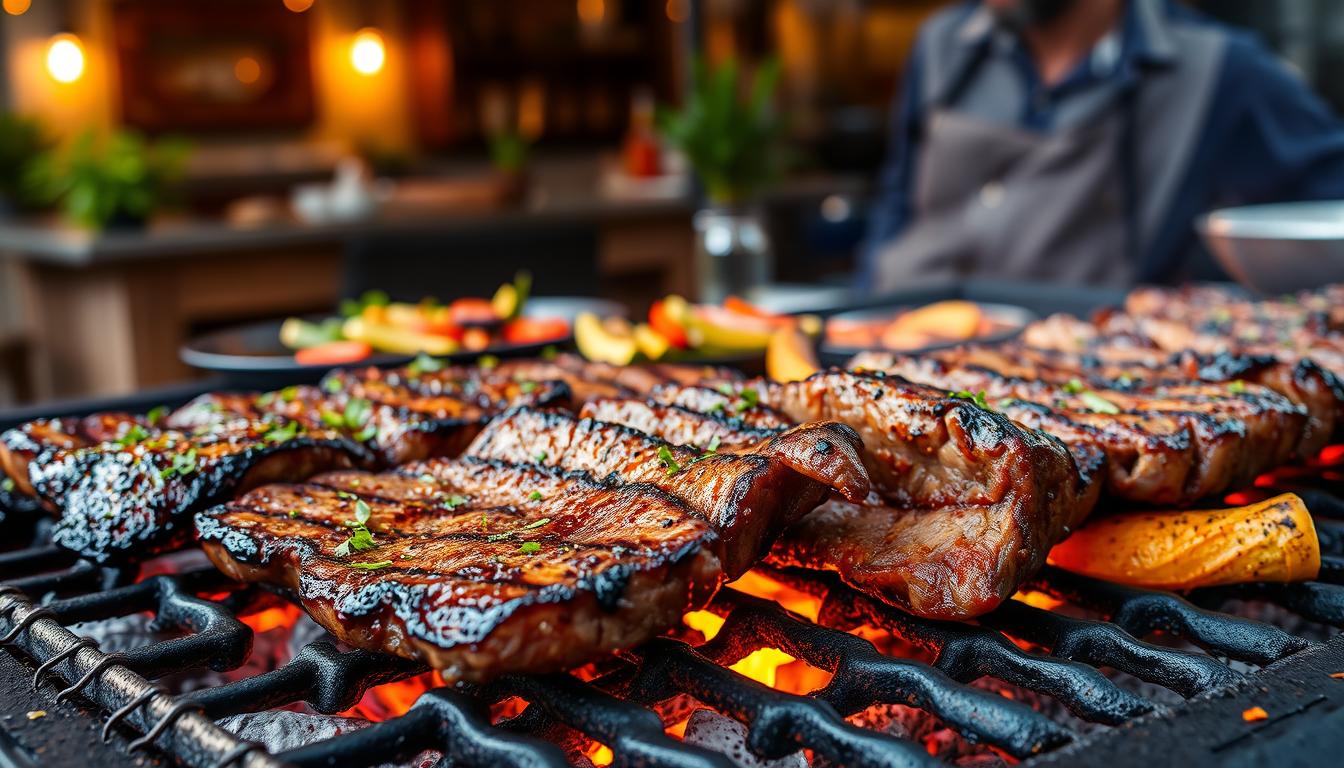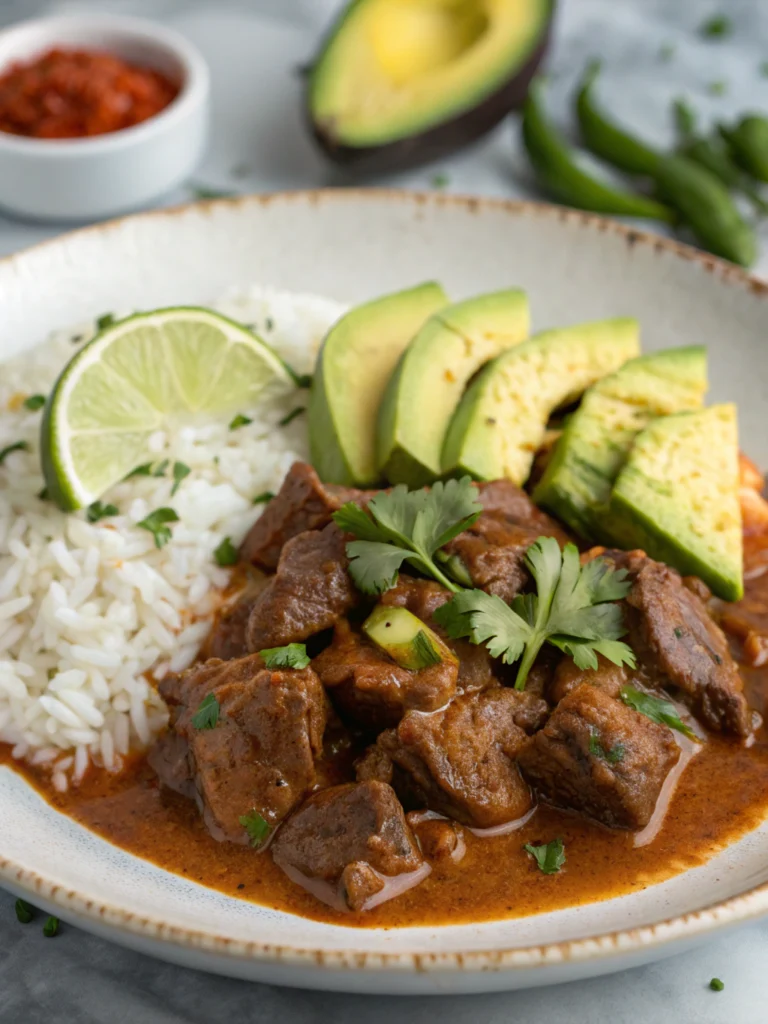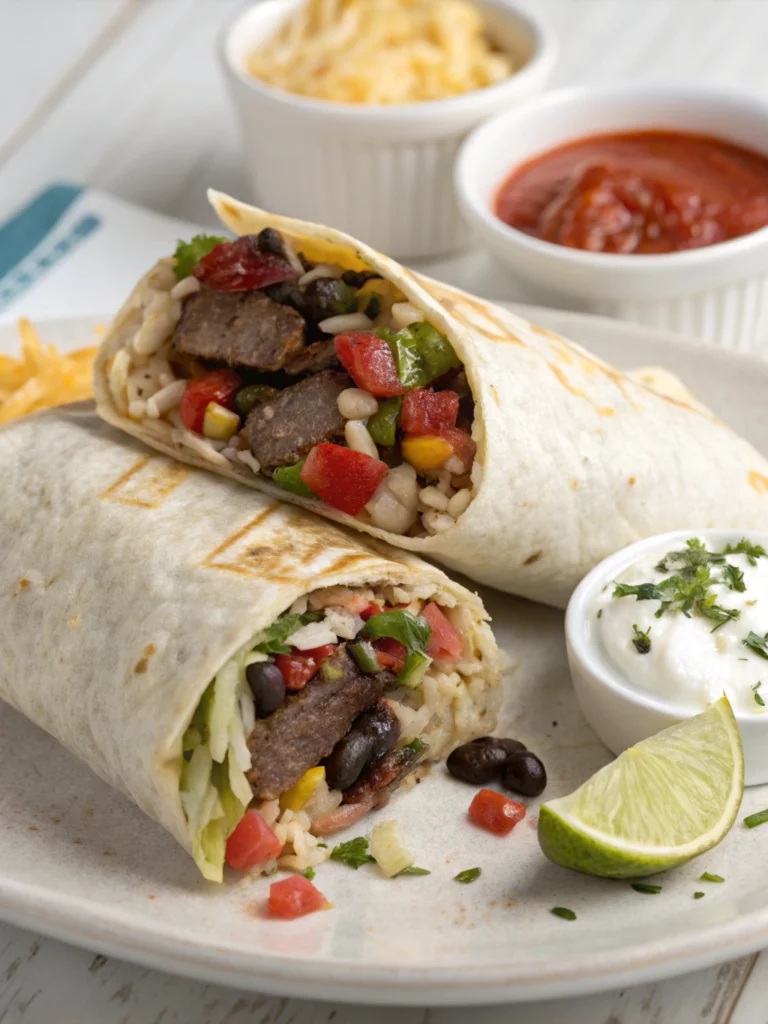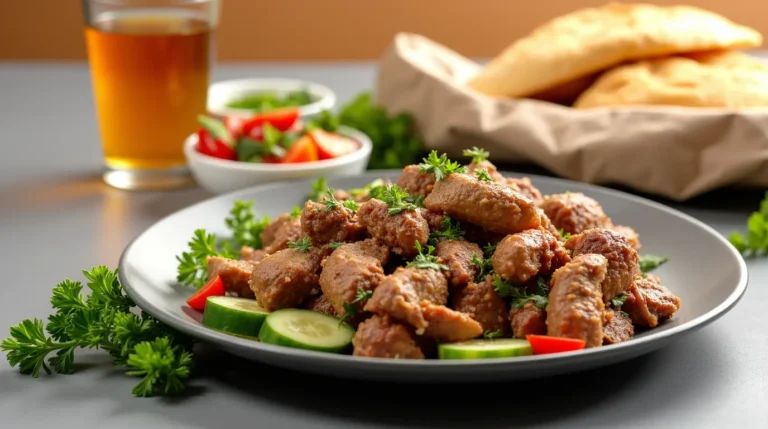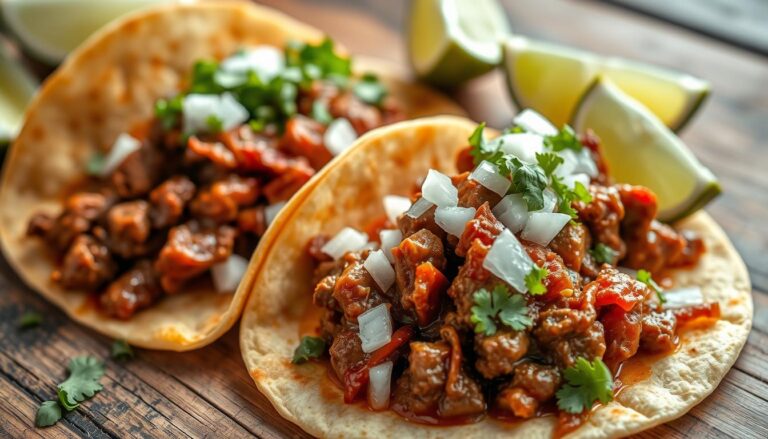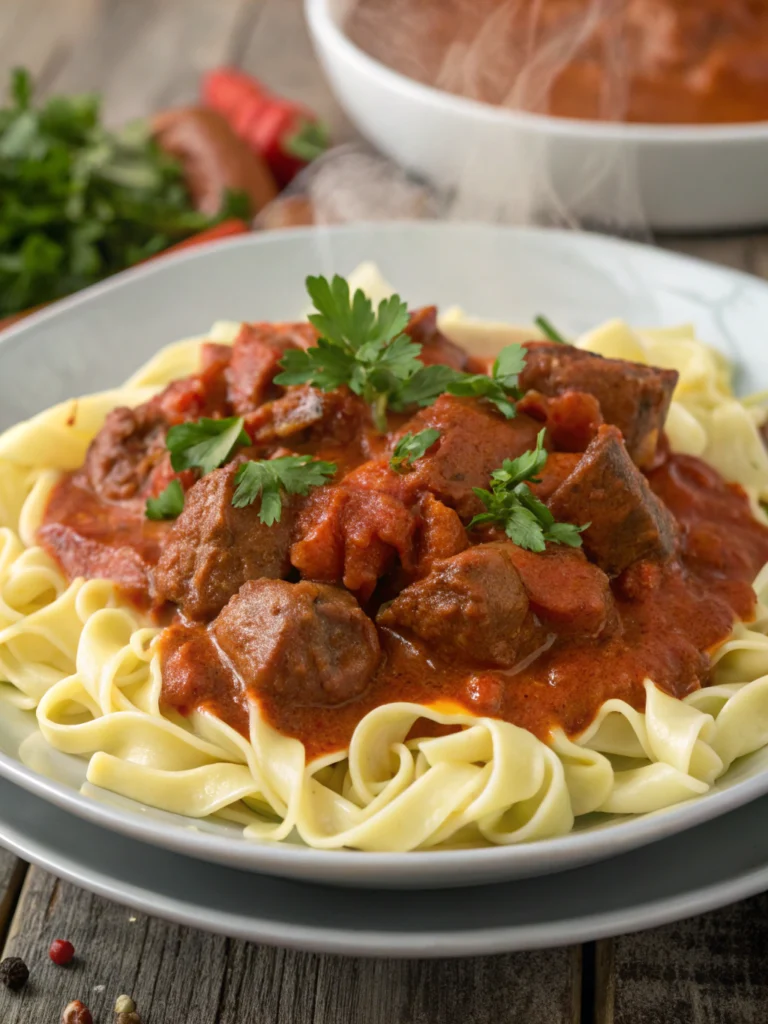7 Delicious and Mouth-Watering Cortes de Carne Recipes to Try Tonight
The sound of meat sizzling on the grill reminds me of Sundays at my grandmother’s. The smell of cooking meat would fill the house, bringing everyone together. Corte de carne recipe are more than food; they connect us and fill our hearts.
My abuela was an expert at choosing the right meat cuts. She marinated flank steak for carne asada and rubbed spices into pork shoulder for carnitas. Her recipes were full of love and flavor.
Today, I want to share the flavors of Latin American cuisine with you. Whether you love the smoky taste of grilled arrachera or the softness of slow-cooked beef, we’ll explore recipes that make dinner special.
We’ll learn how to pick the best cuts and cook them to perfection. Your kitchen will soon smell like my grandmother’s, making everyone want to gather around.
Key Takeaways
- Cortes de carne recipes bring families together through shared food traditions
- Different meat cuts serve specific purposes in Latin American cooking
- Proper selection of meat is the foundation of exceptional dishes
- Cooking techniques vary by cut to achieve ideal tenderness and flavor
- Traditional marinades and seasonings enhance the natural qualities of each cut
- These recipes transform everyday meals into special occasions
Introduction to Cortes de Carne
Cortes de carne is more than cooking meat. It’s a celebration of heritage across Latin American cultures. These dishes have made countless memories at family gatherings and celebrations. Preparing them connects you to centuries of culinary wisdom.
The beauty of cortes de carne recipes is their simplicity. A flank steak sizzling on the grill fills the air with savory aroma. The tender beef and the bright chimichurri sauce make these dishes unforgettable.
In my family, the sound of meat hitting a hot grill signals that something special is happening – it means we’re together, celebrating life through food that speaks to our roots.
Latin America has its own twist on meat dishes, from Argentina’s asado to Mexico’s carne asada. Each region uses local ingredients and cooking methods. The cuts, like ribeye and flank steak, offer unique flavors and textures.
Learning to prepare these beloved cuts brings warmth and connection to your table. Mastering the techniques of selecting, seasoning, and cooking various cortes de carne creates your own traditions and memories.
Understanding Different Cuts of Meat
Stepping up to the butcher counter can feel like entering a foreign country without a map. The array of colors, textures, and names can be overwhelming at first glance. Yet understanding meat cuts transforms ordinary meals into extraordinary dining experiences. The magic of beef cuts recipes begins with selecting the right piece for the right cooking method.
Popular Beef Cuts in Latin American Cuisine
Latin American kitchens celebrate beef in all its glory. The falda (skirt steak) delivers robust flavor with its distinctive grain, perfect for quick grilling or slow braising. Lomo (tenderloin) offers butter-soft texture that melts under your knife. The marbling in ribeye creates self-basting magic, keeping the meat juicy during cooking with meat cuts techniques like grilling or pan-searing.
Pork Cuts and Their Characteristics
Pork brings versatility to your table with cuts that range from delicate to hearty. The shoulder transforms during slow cooking, falling apart at the touch of a fork. Belly cuts cradle layers of fat that render down, creating crispy exterior and succulent interior. Loin delivers clean, mild flavor that pairs beautifully with fruit-based marinades, making it friendly for cooking with meat cuts that require shorter cooking times.
Regional Variations in Meat Selection
Walk through any market in Argentina, and you’ll notice the reverence for thick-cut steaks destined for the parrilla. Mexican families treasure thin-sliced beef for tacos al carbon, while Caribbean cooks prefer tough cuts that transform after hours of gentle simmering. These regional preferences shape beef cuts recipes, each telling stories of cultural history and family traditions.
Identifying Quality Cuts at Your Butcher
Quality meat speaks before you taste it. Look for beef with bright cherry-red color and fine marbling throughout. Fresh pork should appear pink with white fat that feels firm to touch. Ask your butcher about the meat’s age, which affects tenderness when cooking with meat cuts. A good butcher becomes your culinary partner, offering suggestions based on your cooking plans and skill level.
Essential Tools and Ingredients
Cooking with meat cuts starts with the right tools. A quality chef’s knife feels like an extension of your hand. It’s balanced perfectly for slicing through different textures.
Many home cooks love their cast-iron skillet. It’s seasoned with memories of family gatherings. Its surface tells stories of delicious meat dishes.
A reliable meat thermometer is key. It removes guesswork from cooking. Touch the cool metal probe and remember, temperature is the secret to perfectly cooked protein.
A sturdy wooden cutting board is perfect for preparations. It has gentle knife marks from years of use.
Your pantry holds the soul of flavor. Use kosher salt that crumbles between your fingers. Its texture is perfect for creating flavorful crusts.
Fresh black peppercorns release their spicy aroma when crushed. The warm earthiness of cumin and smoky paprika transport you to distant kitchens. There, meat dish ideas have been perfected across generations.
Great meat deserves great respect – the tools you choose and the care you take reflect the love you pour into each dish you create.
No special equipment compares to patience when cooking with meat cuts. A simple pair of tongs gives you control. A heavy-bottomed roasting pan captures precious juices.
Stock your kitchen with fresh garlic, vibrant citrus, and quality olive oil. These humble ingredients can transform ordinary cuts into extraordinary meals.
Classic Cortes de Carne Recipes
Family gatherings in Latin America are not complete without the smell of meat dishes. These classic cortes de carne recipes tell stories of tradition and celebration. They bring people together, sharing flavors that remind us of home and heritage.
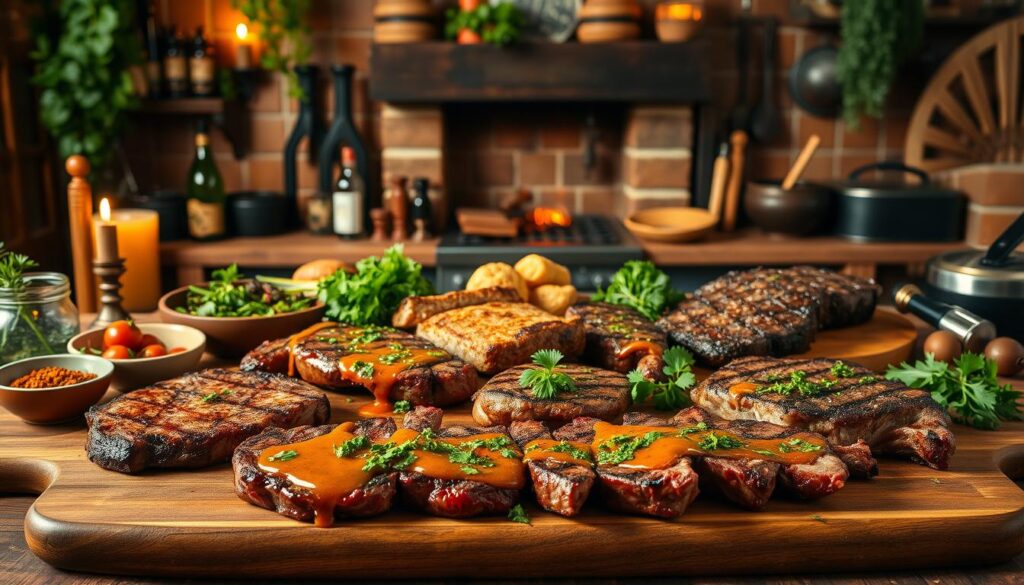
Authentic Carne Asada
Carne asada recipes are simple yet magical. Thin beef is marinated in lime, garlic, and spices. This creates a dish with charred edges and juicy centers, making each bite unforgettable. Families keep their marinade recipes secret, passing them down through generations.
Mouthwatering Bistec Encebollado
This comfort dish turns steak and onions into something special. The onions caramelize, adding sweetness, while the beef absorbs their flavor. The dish fills the kitchen with an irresistible aroma, signaling dinner is ready. The sauce is perfect for dipping warm tortillas.
Traditional Churrasco with Chimichurri
Churrasco celebrates beef in its purest form. Savory steak recipes focus on quality meat cooked over an open flame. It’s then enhanced with a bright, herbaceous chimichurri sauce. This sauce balances parsley, garlic, vinegar, and oil, cutting through the beef’s richness.
Savory Carnitas
Preparing carnitas requires patience, but it’s worth it. These tender pork pieces cook slowly, becoming crispy on the outside and soft on the inside. This transformation shows the beauty of traditional cooking. Each family adds their own twist to this beloved dish.
Flavorful Arrachera (Skirt Steak)
Arrachera’s unique grain makes it perfect for bold marinades. This cut offers intense beef flavor in a thin piece that cooks quickly. It’s a favorite for tacos, fajitas, and standalone dishes, loved at both casual and formal gatherings.
Grilling Techniques for Perfect meat cuts recipes
Grilling turns simple cuts into amazing meals with fire and smoke. The right grilled meat recipes mix skill and instinct. This creates a sizzle and aroma that makes everyone want to eat. Learning a few key techniques can make your steak recipes unforgettable.
Direct vs. Indirect Heat Methods
Direct heat grilling puts meat right over the flames for a great sear. It’s perfect for thin cuts that cook fast. Indirect heat is for thicker cuts, keeping them from burning while cooking slowly.
Many recipes use both methods. Start with direct heat for a crust, then finish with indirect for even cooking.
Achieving the Perfect Temperature
Getting the right temperature is key to juicy meat. Use a meat thermometer for savory steak recipes. Rare is 125°F, medium-rare 135°F, medium 145°F, and well-done 160°F.
Don’t rely on time alone. Thickness, starting temperature, and grill heat can change a lot.
Resting Your Meat: Why It Matters
Resting meat might be hard, but it’s worth it. When meat cooks, juices move to the center. Resting lets these juices spread evenly.
Thin steaks need 5 minutes under foil, while thicker ones take 10-15 minutes. This makes them juicy and flavorful.
Gas vs. Charcoal: Which Is Better for Cortes de Carne
The debate between gas and charcoal grills is fierce. Gas is easy and controls temperature well, great for quick meals. Charcoal gives a smoky flavor that many love.
Both can make amazing food. Choose based on what you value more: flavor or ease of use. Then, practice with your preferred method.
Slow-Cooking Methods for Tender Results
Slow cooking turns tough, cheap cuts into tender delights. A pot of beef chuck or pork shoulder fills your kitchen with anticipation. The slow heat breaks down tough tissues, making the meat soft and juicy.
Many tender meat recipes don’t cost much. Cooking with cuts like brisket, oxtail, or short ribs requires patience. But the slow cooker makes these cuts into special meals that everyone loves.
Latin American cooking is all about slow cooking. Think Mexican barbacoa, where beef cheeks cook for hours, or Cuban ropa vieja, where flank steak becomes tender. These dishes were made from affordable cuts, not fancy ones.
Try braising a tough cut in a Dutch oven at 275°F. Use veggies, wine, and herbs for flavor. The result? Meat so tender, it’s almost like butter.
Flavor Profiles and Marinades
The secret to unforgettable cortes de carne recipes is more than just the cut. It’s the flavors that turn simple meat into a feast. A good marinade doesn’t just add flavor to the surface. It goes deep, creating layers of taste that pop with every bite.
Traditional Latin American Spice Blends
Imagine the earthy warmth of cumin and smoky paprika. This is the heart of Latin American cooking. Classic spice blends like adobo mix, with garlic, oregano, and pepper, add depth to every cut. They turn simple dishes into family traditions.
Citrus-Based Marinades for Brightness
Citrus has magic on tougher cuts. Lime, orange, or grapefruit juice breaks down muscle fibers and adds brightness. Rub skirt steak with lime zest, juice, and a pinch of salt before grilling. The transformation is amazing.
Herb-Infused Oil Rubs
Fresh herbs in warm oil make pastes that cling to meat. They protect it while cooking and add flavor. Mix rosemary, thyme, and cilantro with olive oil, then massage it into your cortes de carne. The oils carry flavor compounds that marinades miss.
Balancing Heat and Sweet in Your Seasonings
The best cortes de carne recipes balance heat and sweet. A bit of brown sugar or honey tames chili heat. This balance adds depth that makes you want more. Try this simple but magical combination on your next cut:
| Ingredient | Quantity | Purpose |
|---|---|---|
| Brown sugar | 1 tablespoon | Sweetness, caramelization |
| Chile powder | 2 teaspoons | Warmth, complexity |
| Sea salt | 1 teaspoon | Flavor enhancement |
| Lime zest | 1 teaspoon | Brightness, aroma |
Finding Quality Cortes de Carne Recipes Online
Looking for authentic cortes de carne recipes can feel like searching forever. The internet is full of choices, but finding the right ones is key. You need recipes that respect tradition and are easy to follow.
When you search for beef cuts recipes online, look for the stories behind them. Good cortes de carne recipes often share family histories or regional backgrounds. These stories show the recipe’s roots and the cook’s passion.
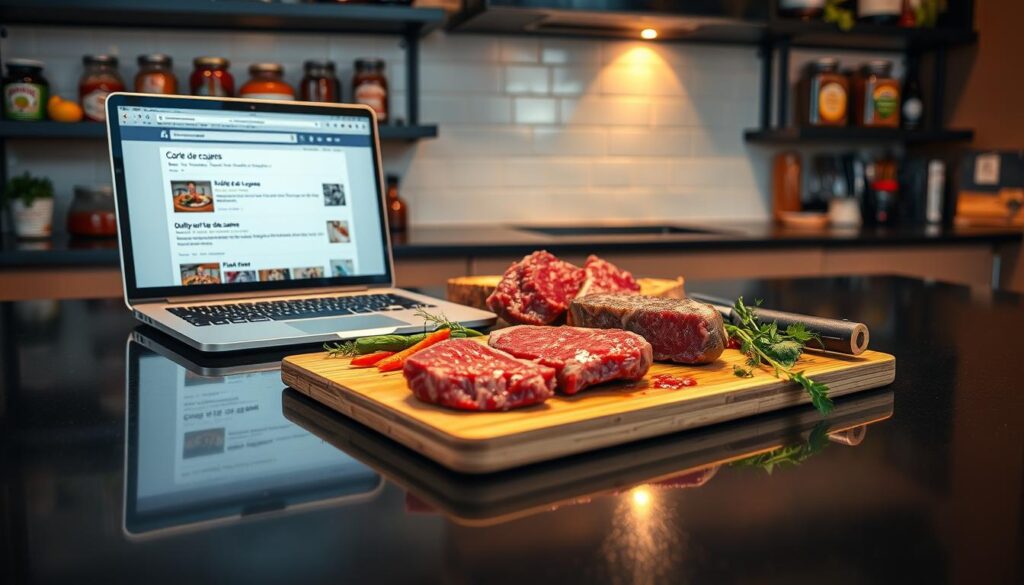
Check out recipe reviews and comments from others who tried the dish. Real cooks share their experiences, tips, and feedback. This helps you find reliable recipes and avoid disappointments.
The magic of cooking lies not just in following instructions, but in understanding the heart behind each dish. Trust recipes that make you feel the warmth of the kitchen they originated from.
Trust your instincts when looking at online recipes. Good beef cuts recipes give clear temperature and resting instructions. They also show how to check if the meat is done right.
The best cortes de carne recipes mix tradition with helpful tips. They guide you in the kitchen but also let you add your own touch. This way, you can make the dish your own.
Creating Complete Meals with Your Meat Dishes
A perfectly cooked cut of meat deserves the right sides to make the meal special. The right sides turn simple meat dishes into unforgettable meals. When planning your next meal, think of the whole plate as a canvas for creativity.
Traditional Side Dishes
Every culture has its own way of pairing meat with sides. Fluffy rice and savory meat juices go well together. Beans with herbs add texture. Salads with fresh veggies offer a nice contrast to meat.
Roasted veggies with herbs and warm tortillas are great for wrapping meat. They add flavor and texture to your meal.
Complementary Sauce Recipes
Sauces add depth to meat dishes with their rich flavors. Chimichurri brightens beef with herbs, while mole adds complexity to poultry. A simple pan sauce made from meat drippings connects your protein to the plate.
Drink Pairings for Different Meat Cuts
The right drink can enhance your meat dishes. Here are some pairing ideas:
| Meat Cut | Recommended Beverage |
|---|---|
| Ribeye | Bold red wine or craft porter |
| Pork shoulder | Amber ale or apple cider |
| Chicken thighs | Chilled rosé or wheat beer |
| Lamb chops | Medium-bodied red or mint tea |
Desserts to Follow Your Main Course
Finish your meal with a dessert that complements your meat. Light fruit desserts clean your palate after rich meats. Dark chocolate with sea salt balances savory and sweet.
A small scoop of vanilla bean ice cream or a simple custard ends your meal nicely.
Conclusion
The sizzle of a perfectly grilled steak and the aroma of spices are unforgettable. The first tender bite of a well-prepared dish is special. These moments are at the heart of cooking with traditional cortes de carne recipes.
Our journey into these recipes is more than just techniques and ingredients. It’s about connecting with cultural traditions. These traditions have brought families together for generations.
When you make your first carne asada recipe, you’re creating a memorable experience. Start with what feels comfortable, like marinating flank steak with citrus and garlic. Then, sear it to perfection.
The beauty of cortes de carne recipes is their simplicity and depth. They’re perfect for weeknight dinners and special occasions alike.
Each cut of meat has its own story, and each preparation method honors a tradition. Whether you’re slow-cooking carnitas or grilling carne asada, remember that cooking shows care. The time you spend cooking brings smiles to your table.
As you start your journey with these beloved dishes, know that practice and patience are key. Your kitchen will become a place of memories. The sounds, smells, and tastes of cortes de carne will become part of your family’s story.
From our kitchen to yours, may your table always be filled with loved ones, laughter, and satisfaction.
Your Cortes de Carne Questions Answered
Starting your cortes de carne cooking journey? You might have questions. Don’t worry, we’re here to help. We’ll guide you to delicious results every time. Whether it’s choosing the right beef cuts or tenderizing meat, we’ve got you covered.
Ever struggled to find specialty cuts at your local market? Don’t worry, you can substitute similar cuts for the same great flavors. And remember, resting your meat is crucial for juicy results.
Facing cooking challenges? We’re here to support you. Reach out anytime for help and advice. Let’s cook up delicious cortes de carne together, one dish at a time.
FAQ
What are the most popular beef cuts used in Latin American cuisine?
In Latin American cooking, favorites include falda (skirt steak), lomo (tenderloin), asado de tira (short ribs), and arrachera (flank steak). These cuts are loved for their rich taste and tender feel when cooked right.
How do I identify quality meat cuts at the butcher?
Choose meat with a bright, even color and little fat marbling. Stay away from dry or discolored pieces. Getting to know your local butcher can also lead to better quality and local favorites.
What are the essential tools and ingredients for preparing cortes de carne?
You’ll need a sharp chef’s knife, a strong cast-iron pan, and a meat thermometer. Don’t forget traditional Latin spices like adobo, fresh citrus, quality olive oil, and herbs. These tools and ingredients will help you cook like a pro at home.
What’s the difference between direct and indirect heat when grilling meat?
Direct heat is great for quickly searing the outside and making a tasty crust. Indirect heat cooks the meat more gently, ensuring it’s evenly done. Learning both methods will help you grill cortes de carne perfectly.
How do I balance the flavors in my cortes de carne seasoning?
Aim for a mix of heat, acidity, and sweetness. Start with earthy spices like cumin and oregano. Then, add citrus and a bit of brown sugar or honey. Taste and adjust until the flavors pop.
Where can I find authentic, high-quality cortes de carne recipes online?
Look for recipes with personal stories, cultural background, and detailed steps. Choose sites that treat these dishes with respect and care. Reading reviews can also guide you to well-loved and tested recipes.

